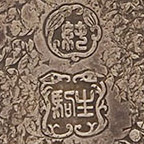
G. Ikoma [生駒時計店] (1870 ~ today)

Gonshichi Ikoma.

The Ikoma Building in 1930: outside (left) and inside (right).

The G. Ikoma branch store in 1960s.

The Ikoma building today.
Addresses and locations
Koraibashi 4-chome, Chuo-ku, Osaka.
Koraibashi 5-chome, Chuo-ku, Osaka.
Yodoyabashi Dori, Koraibashi South, East District, Osaka.
Marks
The trade mark of the G. Ikoma company:
a framed 生 kanji
a framed 生 kanji
生駒
Ikoma
Ikoma
Same as above, but with 純 (pure)
Top: 純銀 - Jungin - "pure silver"
Bottom: 生駒製
生駒 (Ikoma) 製 (made by)
Ikoma sei
made by Ikoma
Same as above, but with English "silver" instead of Japanese 純銀
Top: 純銀 - Jungin - "pure silver"
Bottom: 生駒製
生駒 (Ikoma) 製 (made by)
Ikoma sei
made by Ikoma
Labels and stickers
Individual marks of artists from the G. Ikoma company
Advertisements
Examples (from the web)
References
G. Ikoma website.
Ikoma Building historical website.
History of the Ikoma Building, by Ikko Sakai, 生駒ビルヂング, 酒井一光, 2011.
History of the G. Ikoma company. Archived.
黒住教信徒成功談: 立教百年祭記念, 1914, pp.14-16.












































